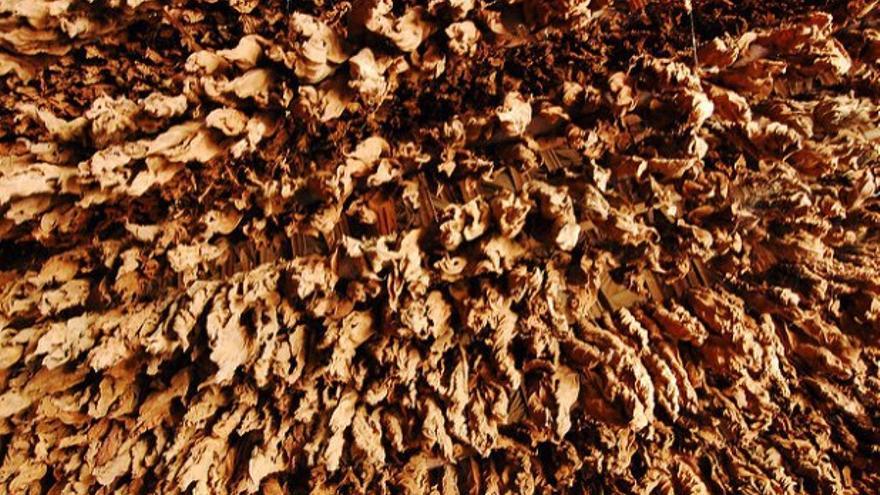
![]() 14ymedio, Marcelo Hernandez, San Juan y Martínez | Mayo 24, 2018 — “Everything was going well and then the rains came,” says Manuel García, summarizing the situation of Hoyo de Monterrey, in Pinar del Río, where the best tobacco in the world is grown. The intense showers of recent days in the western part of the Island in the middle of the harvest are making the situation difficult.
14ymedio, Marcelo Hernandez, San Juan y Martínez | Mayo 24, 2018 — “Everything was going well and then the rains came,” says Manuel García, summarizing the situation of Hoyo de Monterrey, in Pinar del Río, where the best tobacco in the world is grown. The intense showers of recent days in the western part of the Island in the middle of the harvest are making the situation difficult.
“The harvesting of the leaf is a very delicate moment,” Garcia explains to 14ymedio. “A lot of humidity damages tobacco.” In his drying houses, close to the land of the Rigoberto Fuentes Cooperative in the San Juan y Martinez municipality, water seeps in everywhere and the tobacco grower fears that “the leaf will deteriorate and can’t be sold at the same price.”
The cigar makers must sell their products to the State, which rates the leaves by quality parameters, among which are size, smoothness and color. “With so much rain it is to be expected that there will be losses because the farmer who sowed expecting to have a first quality leaf, will have to sell it cheaper if it deteriorates,” says the producer.
García grows the tapada variety, which grows under a cloth that filters sunlight and produces the leaves for the outer layers of the most sought-after cigars. “The product that comes from here goes mainly to the cigars that are exported or sold in stores in hard currency,” he explained. “That’s why they are very demanding,” he says.

The tobacco is planted by private farmers, cooperatives and producers who lease land from the state, in the Tabaco Business Group of Cuba, (Tabacuba), an extensive state structure composed of more than 45 companies including agricultural, agroindustrial, twisted tobacco, marketing and research.
In total, the Group manages 96 factories where cigars are made by hand and almost half of them are dedicated exclusively to exports. The rest, where industrially produced cigars and cigarettes are produced, go to the national market.
For Tabacuba these days of May are vital, because the leaf that is harvested in the fields and begins to dry will define the amount of their production and their ability to fulfill international commitments.
In a sector that contributes more than 400 million dollars a year from exports, tension is felt everywhere. After the last weather reports that assure that the rains will continue, the alarm has grown even more between the cultivators and the state administrators.
“By the middle of this month we already had about 30 million cujes collected and we thought we could harvest up to 20,000 hectares,” says an employee of Tabacuba in Pinar del Río. “This was going to be one of the biggest crops in recent years but the weather may force us to redefine those initial plans.”
Tobacco occupies fourth place in the Cuban economy and employs, in the normal season, about 150,000 workers, and up to a quarter of a million during the harvest. Among the most recognized Cuban brands in the world are Cohiba, Montecristo, Partagas and Romeo y Julieta.
The Vueltabajo area, where the Hoyo de Monterrey is located, produces approximately 70% of the national tobacco production. The damage caused by heavy rains, with waterlogged lands and soggy drying houses takes a special toll on the farmers.
“The weather situation is disastrous because all the tobacco that gets wet in the fields loses between 30 and 40% of quality,” explains Alfredo Pérez González, who lives on La Isleña farm and is in charge of the administrative part of this family enclave where several generations have traditionally cultivated the leaf.
“The problem is that the tobacco that is now spoiling in the fields because of the excess rain is not covered by insurance,” explains the young man. The National Insurance Company (Esen) only protects the tobacco crops that were “planted before January 31 and are the ones that have already been collected,” he adds.
The tobacco growers, however, take the risk every year to make a second planting after that time to be picked in the month of May. “It is a risky bet, luckily and truthfully, because if tobacco is lost or the harvest is damaged, the State does not pay a single peso,” says Pérez.
“Although May is always a rainy season, it’s been more than 30 years since we saw a month with so much rain.” A considerable part of the harvest “was still in the field and another part was recently harvested and that too is endangered by the increase in relative humidity that prevents the tobacco from drying as it should in the drying houses.”
“The affects are immense and the farmer has no support for what is happening,” says Pérez.
______________________
The 14ymedio team is committed to serious journalism that reflects the reality of deep Cuba. Thank you for joining us on this long road. We invite you to continue supporting us, but this time by becoming a member of 14ymedio. Together we can continue to transform journalism in Cuba.
